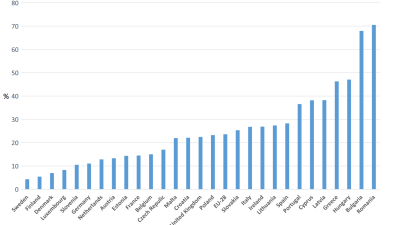Over the last 30 years, it could have been expected that fewer and fewer people would be unable to afford individual items seen as necessities, as household incomes rose during this period. However, there was little change. The table in the link below gives details of all the items examined in the 1983 and 1990 Breadline Britain surveys and the 1999 PSE survey.
|
% |
% |
% |
| Beds and bedding for everyone |
1 |
1 |
1 |
| Heating to warm living areas of the home |
3 |
3 |
5 |
| Damp-free home |
6 |
2 |
7 |
| Two meals a day |
1 |
1 |
3 |
| Refrigerator |
<0.5 |
1 |
2 |
| Fresh fruit and vegetables daily |
5 |
6 |
|
| Warm, waterproof coat |
4 |
4 |
7 |
| Celebrations on special occasions |
2 |
4 |
4 |
| Money to keep home in a decent state of decoration |
15 |
15 |
|
| Meat, fish or vegetarian equivalent every other day |
2 |
3 |
8 |
| Insurance of contents of dwelling |
10 |
10 |
|
| Hobby or leisure activity |
7 |
6 |
7 |
| Washing machine |
2 |
4 |
6 |
| Telephone |
2 |
7 |
11 |
| Carpets in living rooms and bedrooms |
2 |
2 |
2 |
| Regular savings (of £10 per month) for rainy days or retirement |
27 |
30 |
|
| Two pairs of all-weather shoes |
7 |
5 |
9 |
| Friends or family round for a meal |
6 |
10 |
11 |
| Television |
<0.5 |
1 |
<0.5 |
| Roast joint/vegetarian equivalent once a week |
4 |
6 |
7 |
| Presents for friends/family yearly |
4 |
5 |
5 |
| Holiday away from home once a year not with relatives |
18 |
20 |
21 |
| An outfit for social occasions |
5 |
8 |
10 |
| New, not second-hand, clothes |
6 |
4 |
6 |
| Car |
11 |
18 |
22 |
| Coach/train fares to visit friends/family quarterly |
19 |
19 |
|
| An evening out once a fortnight |
17 |
14 |
17 |
| Dressing gown |
1 |
2 |
3 |
| A meal in a restaurant/pub monthly |
21 |
22 |
|
| Video cassette recorder |
2 |
11 |
|
| Holidays abroad once a year |
29 |
32 |
|
| Home computer |
17 |
16 |
|
| Dishwasher |
11 |
18 |
|
See also Facts and Findings 2: Going backwards, 1983 - 2012
The greatest change was in items not counted as necessities; in particular, video, dishwasher and car – all of which became relatively cheaper over this 17-year period. The only item considered to be a necessity by a majority of the population for which there was a big drop was the telephone – with only 2 per cent unable to afford one in 1999 compared with 7 per cent in 1990 and 11 per cent in 1983 when only a minority considered it a necessity.
In the case of several necessities, deprivation rose between 1990 and 1999. The number of households unable to afford a ‘damp-free home’, ‘two pairs of all-weather shoes’ and ‘new, not second-hand clothes’ all increased. In each case this rise followed a fall in the 1980s.
Only slightly fewer households could afford a home computer in 1999 than in 1990, despite the huge fall in the price of computers in real terms over the 1990s.



 PSE:UK is a major collaboration between the University of Bristol, Heriot-Watt University, The Open University, Queen's University Belfast, University of Glasgow and the University of York working with the National Centre for Social Research and the Northern Ireland Statistics and Research Agency. ESRC Grant RES-060-25-0052.
PSE:UK is a major collaboration between the University of Bristol, Heriot-Watt University, The Open University, Queen's University Belfast, University of Glasgow and the University of York working with the National Centre for Social Research and the Northern Ireland Statistics and Research Agency. ESRC Grant RES-060-25-0052.






